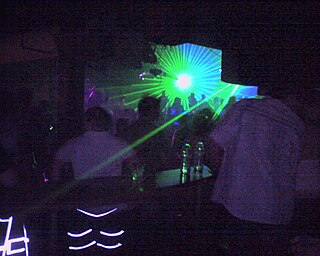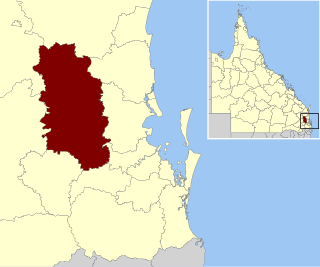Related Research Articles

Ipswich is a city in South East Queensland, Australia. Situated on the Bremer River, it is approximately 40 kilometres (25 mi) west of the Brisbane central business district. The city is renowned for its architectural, natural and cultural heritage. Ipswich preserves and operates from many of its historical buildings, with more than 6000 heritage-listed sites and over 500 parks. Ipswich was founded in 1827 as a mining settlement. The suburb of the same name is its central business district.

South East Queensland (SEQ) is a bio-geographical, metropolitan, political and administrative region of the state of Queensland in Australia, with a population of approximately 3.8 million people out of the state's population of 5.1 million. The area covered by South East Queensland varies, depending on the definition of the region, though it tends to include Queensland's three largest cities: the capital city Brisbane; the Gold Coast; and the Sunshine Coast. Its most common use is for political purposes, and covers 35,248 square kilometres (13,609 sq mi) and incorporates 11 local government areas, extending 240 kilometres (150 mi) from Noosa in the north to the Gold Coast and New South Wales border in the south, and 140 kilometres (87 mi) west to Toowoomba. It is the third largest urban area in Australia by population.

The Bremer River is a river that is a tributary of the Brisbane River, located in the Scenic Rim and Brisbane regions of South East Queensland, Australia. The 100-kilometre (62 mi)-long Bremer River drains several Scenic Rim valleys in south-east Queensland, including the Fassifern Valley, with its catchment area covering approximately 2,032 square kilometres (785 sq mi). Most valleys within the catchment have extensive river terraces. The Bremer River system is extremely degraded.

The Lockyer Valley is an area of rich farmlands that lies to the west of Brisbane, Queensland, Australia and east of Toowoomba. The Lockyer Valley is rated among the top ten most fertile farming areas in the world, and the intensively cultivated area grows the most diverse range of commercial fruit and vegetables of any area in Australia. The valley is referred to as "Australia's Salad Bowl" to describe the area as one of Australia's premium food bowls.

In 1975, Brisbane's first FM radio station began broadcasting from a studio at the University of Queensland Student Union. 4ZZ became a catalyst for the development of original music in the city. Bands such as The Saints, The Go-Betweens, gerrymander and the boundaries, The Riptides and The Laughing Clowns established an ecosystem for alternative music that continues to flourish.

Springfield railway line is a 13.6 km (8.5 mi) suburban railway line in Brisbane, Australia that branches from the Ipswich/Rosewood line after Darra railway station. Construction of the line started on 5 July 2010, and it opened on 2 December 2013. The line was developed along with the widening of the nearby Centenary Motorway.

Ipswich Road is major road in the City of Brisbane, Queensland, Australia. The road has been an important transport route since the 19th century when it connected the towns of Brisbane and Ipswich. In the 1990s, the section from Moorooka in Brisbane to Riverview in Ipswich was replaced by the Ipswich Motorway.

The City of Ipswich is a local government area in Queensland, Australia, located within the southwest of the Brisbane metropolitan area, including the urban area surrounding the city of Ipswich and surrounding rural areas.

The road transport in Brisbane, Australia, consists of a network of highways, freeways and motorways. Some motorways have tolls applied.

The Somerset Region is a local government area located in the West Moreton region of South East Queensland, Australia, about 100 kilometres (62 mi) northwest of Brisbane and centred on the town of Esk. It was created in 2008 from a merger of the Shire of Esk and the Shire of Kilcoy. It is commonly known as the Brisbane Valley, due to the Brisbane River which courses through the region, although significant parts of the region lie outside the hydrological Brisbane Valley itself.

Muirlea is a rural locality in the City of Ipswich, Queensland, Australia. In the 2021 census, Muirlea had a population of 174 people.
The Shire of Moreton was a local government area in South East Queensland, Australia, located about 50 kilometres (31 mi) southwest of Queensland's capital, Brisbane. It represented an area surrounding but not including Ipswich, and existed from 1917 until 1995, when it merged into the City of Ipswich, City of Brisbane, and Shire of Esk.

Ripley is a suburb in the City of Ipswich, Queensland, Australia. In the 2016 census, Ripley had a population of 1,405 people.

Deebing Heights is a residential and semi-rural southern suburb of Ipswich in the City of Ipswich, Queensland, Australia. In the 2016 census, Deebing Heights had a population of 2,039 people.

South Ripley is a rural locality and suburb of Ipswich in the City of Ipswich, Queensland, Australia. South Ripley is part of the Ecco Ripley urban development area. In the 2016 census, South Ripley had a population of 712 people.

Howard Smith Wharves is a heritage-listed wharf on the Brisbane River at Boundary Street, Brisbane City and Fortitude Valley, City of Brisbane, Queensland, Australia. It was built from 1939 to 1942. It is also known as Brisbane Central Wharves. The 3.5-hectare (8.6-acre) site is one of the most culturally and historically significant riverfront locations in Brisbane. It was added to the Queensland Heritage Register on 4 February 1997.

Yarrabilba is a locality in the City of Logan, Queensland, Australia. In the 2021 census, Yarrabilba had a population of 10,240 people.

The Western Corridor NRL bid is a proposed NRL team to be based in Brisbane's growing Western Corridor in an expanded National Rugby League competition. The Western Corridor NRL bid was launched on 14 August 2010. The bid is headquartered in Ipswich, Queensland and is closely associated with the Ipswich Jets.

Karl Langer (1903–1969) was an Austrian-born architect in Queensland, Australia. A number of his works are listed on the Queensland Heritage Register.

Flinders Lakes is a rural locality in the City of Logan, Queensland, Australia. It was gazetted in May 2016.
References
- ↑ Jane Chudleigh (31 October 2012). "Sekisui House launch Ecco Ripley Central which will become Australia's largest master-planned community". couriermail.com.au. News Limited. Retrieved 17 July 2013.
- ↑ "Sekisui House's Ecco Ripley first for Queensland". The Fifth Estate. 13 March 2010. Retrieved 17 July 2013.
- ↑ Marissa Calligeros (26 May 2010). "Three new cities for state's south-east". Brisbane Times. Fairfax Media. Retrieved 17 July 2013.
- 1 2 3 Tony Moore (27 May 2010). "Japanese to build new SEQ 'city'". Brisbane Times. Fairfax Media. Retrieved 17 July 2013.
- 1 2 3 "Roadworks kick-start Ripley Valley progress". Queensland Times. 10 May 2013. Retrieved 17 July 2013.
- 1 2 Geoff Egan (4 April 2013). "Rail line vital to future of Ripley Valley housing projects". Queensland Times. Retrieved 17 July 2013.
- ↑ Tony Moore (3 November 2012). "Growing pains continue despite slow-down". Brisbane Times. Fairfax Media. Retrieved 17 July 2013.
- ↑ "Ecco Ripley". Sekisui House Australia Holdings. Archived from the original on 1 May 2013. Retrieved 17 July 2013.
- ↑ Geoff Egan (1 November 2012). "Massive housing project launches". Queensland Times. Retrieved 17 July 2013.
- ↑ Geoff Egan (5 June 2013). "Hospital and Ripley our big budget winners". Queensland Times. Retrieved 17 July 2013.